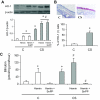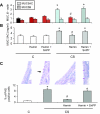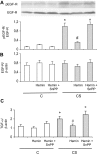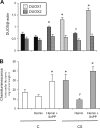Heme oxygenase-1 prevents airway mucus hypersecretion induced by cigarette smoke in rodents and humans
- PMID: 18787101
- PMCID: PMC2543067
- DOI: 10.2353/ajpath.2008.070863
Heme oxygenase-1 prevents airway mucus hypersecretion induced by cigarette smoke in rodents and humans
Erratum in
- Am J Pathol. 2008 Dec;173(6):1929. Leynaert, A Benedicte [corrected to Leynaert, Benedicte]
Abstract
We investigated the role of heme oxygenase-1 (HO-1), a powerful anti-inflammatory and anti-oxidant enzyme, in modulating cigarette smoke (CS)-induced mucus secretion. In both rats and mice, 5-day CS exposure increased HO-1 expression and activity, mucus secretion, MUCIN 5AC (MUC5AC) gene and protein expression, and local inflammation, along with up-regulation of dual oxidase 1 gene expression and both the activity and phosphorylation of the epidermal growth factor receptor, which is involved in MUC5AC induction. Pharmacological induction of HO-1 prevented these actions and inhibition of HO-1 expression by a specific siRNA potentiated them. In French participants to the European Community Respiratory Health Survey II (n = 210, 30 to 53 years of age, 50% males) exposed to CS, a significant increase in the percentage of participants with chronic sputum was observed in those harboring at least one allele with a long (GT)(n) in the HO-1 promoter gene (>33 repeats), which is associated with a low level of HO-1 protein expression, compared with those with a short number of (GT)n repeats (21.7% versus 8.6%, P = 0.047). No such results were observed in those who had never smoked (n = 297). We conclude that HO-1 has a significant protective effect against airway mucus hypersecretion in animals and humans exposed to CS.
Figures







Similar articles
-
Phloretin attenuates mucus hypersecretion and airway inflammation induced by cigarette smoke.Int Immunopharmacol. 2018 Feb;55:112-119. doi: 10.1016/j.intimp.2017.12.009. Epub 2017 Dec 22. Int Immunopharmacol. 2018. PMID: 29245072
-
HO-1 inhibits IL-13-induced goblet cell hyperplasia associated with CLCA1 suppression in normal human bronchial epithelial cells.Int Immunopharmacol. 2015 Dec;29(2):448-453. doi: 10.1016/j.intimp.2015.10.016. Epub 2015 Oct 24. Int Immunopharmacol. 2015. PMID: 26507166
-
Attenuation of cigarette smoke-induced airway mucus production by hydrogen-rich saline in rats.PLoS One. 2013 Dec 20;8(12):e83429. doi: 10.1371/journal.pone.0083429. eCollection 2013. PLoS One. 2013. PMID: 24376700 Free PMC article.
-
Rho-kinase inhibitor fasudil reduces allergic airway inflammation and mucus hypersecretion by regulating STAT6 and NFκB.Clin Exp Allergy. 2015 Dec;45(12):1812-22. doi: 10.1111/cea.12606. Clin Exp Allergy. 2015. PMID: 26245530
-
Heme Oxygenase-1/CO as protective mediators in cigarette smoke- induced lung cell injury and chronic obstructive pulmonary disease.Curr Pharm Biotechnol. 2012 May;13(6):769-76. doi: 10.2174/138920112800399338. Curr Pharm Biotechnol. 2012. PMID: 22201606 Review.
Cited by
-
Intratracheally administered titanium dioxide or carbon black nanoparticles do not aggravate elastase-induced pulmonary emphysema in rats.BMC Pulm Med. 2012 Jul 31;12:38. doi: 10.1186/1471-2466-12-38. BMC Pulm Med. 2012. PMID: 22849372 Free PMC article.
-
Heme oxygenase-1 accelerates cutaneous wound healing in mice.PLoS One. 2009 Jun 4;4(6):e5803. doi: 10.1371/journal.pone.0005803. PLoS One. 2009. PMID: 19495412 Free PMC article.
-
Cigarette smoke promotes dendritic cell accumulation in COPD; a Lung Tissue Research Consortium study.Respir Res. 2010 Apr 26;11(1):45. doi: 10.1186/1465-9921-11-45. Respir Res. 2010. PMID: 20420706 Free PMC article.
-
The Role of Nrf2 in Cellular Innate Immune Response to Inflammatory Injury.Toxicol Res. 2009 Dec;25(4):159-173. doi: 10.5487/TR.2009.25.4.159. Epub 2009 Dec 30. Toxicol Res. 2009. PMID: 32038834 Free PMC article. Review.
-
HO-1 protects smokers exposed to artificial stone dust for pulmonary function tests deterioration.Sarcoidosis Vasc Diffuse Lung Dis. 2018;35(3):276-284. doi: 10.36141/svdld.v35i3.6968. Epub 2018 Apr 28. Sarcoidosis Vasc Diffuse Lung Dis. 2018. PMID: 32476913 Free PMC article.
References
-
- Barnes PJ, Shapiro SD, Pauwels RA. Chronic obstructive pulmonary disease: molecular and cellular mechanisms. Eur Respir J. 2003;22:672–688. - PubMed
-
- American Thoracic Society Standards for the diagnosis and care of patients with chronic obstructive pulmonary disease (COPD) and asthma. Am Rev Respir Dis. 1987:225–244. - PubMed
-
- Vestbo J, Prescott E, Lange P. Association of chronic mucus hypersecretion with FEV1 decline and chronic obstructive pulmonary disease morbidity. Copenhagen City Heart Study Group. Am J Respir Crit Care Med. 1996;153:1530–1535. - PubMed
-
- Vestbo J. Chronic mucus hypersecretion, exacerbations and natural history of COPD. Exp Lung Res. 2005;31(Suppl 1):63–65. - PubMed
Publication types
MeSH terms
Substances
LinkOut - more resources
Full Text Sources
Molecular Biology Databases
Research Materials
Miscellaneous

